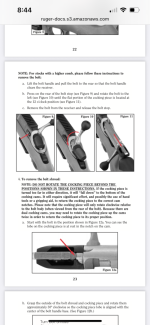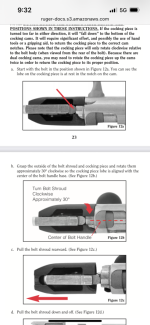You are using an out of date browser. It may not display this or other websites correctly.
You should upgrade or use an alternative browser.
You should upgrade or use an alternative browser.
Ruger American Ranch 5.56 Bolt Won’t Lock — Need Help Diagnosing
- Thread starter Sidhuman
- Start date
No, the scope on there for over a yearDid you install a scope rail recently?
On or off, it's the sameIs your safety on? A buddy had the same issue on an old school Tikka
which firearms function in that manner
Almost all of them bro.
I got got google to help me, as my first hand handled experience with this was limited to 2 pistols i owned, a break action shotgun, and a couple hunting rifles, but enough to know it was common throughout the industry.
Many modern bolt-action rifles (Remington 700, Winchester Model 70, Tikka, Savage, etc.) have spring-loaded firing pins.
After striking the primer, the firing pin is immediately pulled back flush by the spring.
So when you open the bolt, you won’t see the firing pin protruding.
Inertia firing pins are shorter than the channel.
The hammer (or striker) strikes the rear, and momentum drives it forward into the primer.
Once the energy is spent, it rests back flush with or slightly behind the breechface.
Examples:
1911 pistols
Browning Hi-Power
Many break-action shotguns
Glocks, M&Ps, SIG P320s, etc.
The striker protrudes only during the actual strike.
At rest, it is pulled back flush and cannot stick out past the breechface.
Last edited:
- Location
- Van. Is. B.C.
Ruger owners instruction state that there are two cocking cams cut into the bolt. It states “Please note that the cocking piece will only rotate clockwise, relative to the bolt body (when viewed from the rear of the bolt). Because there are dual cocking cams, you may need to rotate the cocking piece up the cocking cams twice in order to return the cocking piece to the correct position.”
I don’t know if this helps or not but it is interesting that they would cut two cocking cams.
I don’t know if this helps or not but it is interesting that they would cut two cocking cams.
Is it a gen 2 ? I read that some cōck upon closing the bolt. But this shows different. Gunna post a link. And a screenshot of a page.
To me it’s sounding like the bolt isn’t cocked too. And it will need to be cocked before entry
https://ruger-docs.s3.amazonaws.com/_manuals/RAR-GenerationII.pdf

To me it’s sounding like the bolt isn’t cocked too. And it will need to be cocked before entry
https://ruger-docs.s3.amazonaws.com/_manuals/RAR-GenerationII.pdf

Yeah, there is a tool you can get to make it easy, without it, nightmare city lolI've had my Gen II bolt apart for polishing & it was a burger to reassemble correctly. I'm gonna say it's something with your bolt.
LOL, ya I found that AFTER I had all the troubles.Yeah, there is a tool you can get to make it easy, without it, nightmare city lol
It was in storage for about a year. It was working fine before I stored it, bolt was stored separately in the safe and it didn't close when I tried to use it at the range revently. I removed the black cap to move the clocking piece cause that's the only information I could find on YouTube. Apparantly the clocking piece is in the right position and there is no dirt or debris that are blocking the bolt to close.So you cleaned it. Disassembled the bolt and cleaned it (removing the black cap would require partial disassembly). Did you perform a function check before long term storage? At what point in your range trip did it start malfunctioning
I will post some pictures as soon as I get home, but I checked this and the cocking piece is at the right location. That's not the problem.I think it’s time your post some pics of your bolt like similar angles to these photos
View attachment 1020311
BigUglyMan
CGN Ultra frequent flyer
- Location
- New Scotland
Well, with a few exceptions (notably the Lee-Enfield), when you open the bolt you are cocking the mechanism, which draws the firing pin back. If you remove the bolt from the rifle and de-#### it outside the rifle, you will see the firing pin protrude. The vast majority of firing pins in rifles are spring loaded, but they're spring loaded in the opposite orientation...pushing forward, not to the rear. That is why shooters and hunters are strongly discouraged from loading a round into the chamber and decocking the action by pulling the trigger while you close the bolt handle, because the firing pin will be left resting on the primer and could be inadvertently set off by a sharp blow, say, in a fall.Almost all of them bro.
I got got google to help me, as my first hand handled experience with this was limited to 2 pistols i owned, a break action shotgun, and a couple hunting rifles, but enough to know it was common throughout the industry.
Many modern bolt-action rifles (Remington 700, Winchester Model 70, Tikka, Savage, etc.) have spring-loaded firing pins.
After striking the primer, the firing pin is immediately pulled back flush by the spring.
So when you open the bolt, you won’t see the firing pin protruding.
Google is great, but it's not always right.
Not one of the bolt action rifles you list, nor any cf bolt action rifle I am aware of uses a floating firing pin.Almost all of them bro.
I got got google to help me, as my first hand handled experience with this was limited to 2 pistols i owned, a break action shotgun, and a couple hunting rifles, but enough to know it was common throughout the industry.
Many modern bolt-action rifles (Remington 700, Winchester Model 70, Tikka, Savage, etc.) have spring-loaded firing pins.
After striking the primer, the firing pin is immediately pulled back flush by the spring.
So when you open the bolt, you won’t see the firing pin protruding.
Inertia firing pins are shorter than the channel.
The hammer (or striker) strikes the rear, and momentum drives it forward into the primer.
Once the energy is spent, it rests back flush with or slightly behind the breechface.
Examples:
1911 pistols
Browning Hi-Power
Many break-action shotguns
Glocks, M&Ps, SIG P320s, etc.
The striker protrudes only during the actual strike.
At rest, it is pulled back flush and cannot stick out past the breechface.
Last edited:







































































